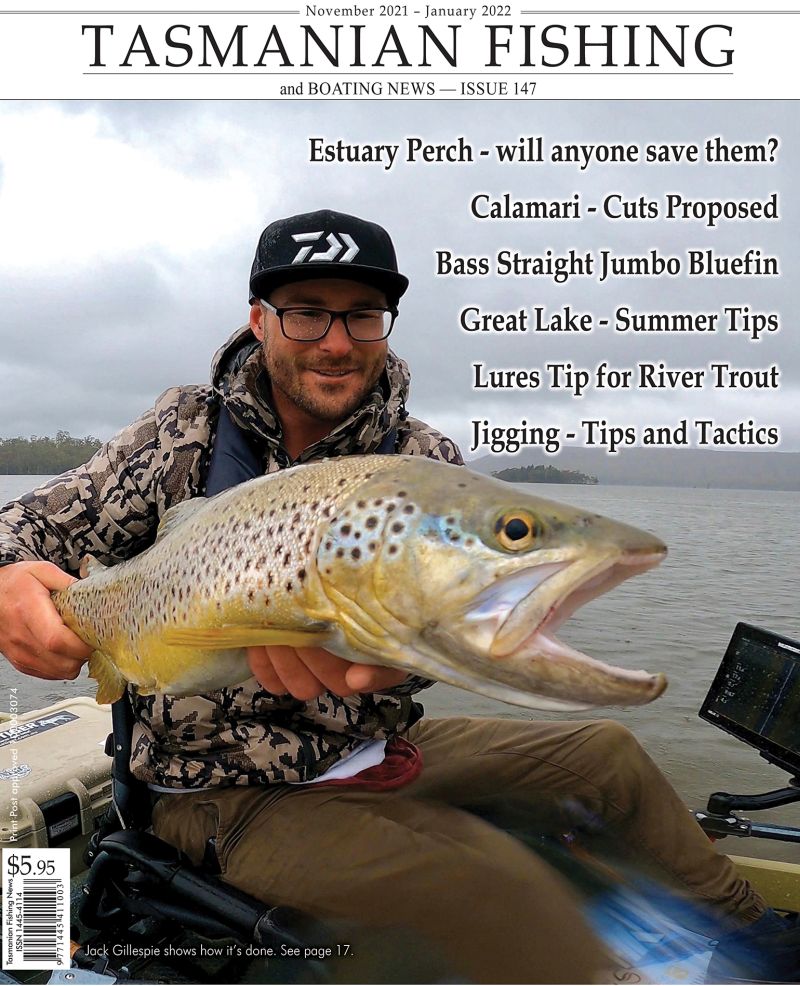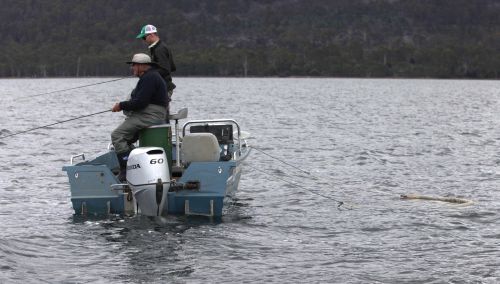From the Archives ...
Sea Run Trout
Mid Sea-Run Season Report
Sea-run trout fishing this year got off to a cracking start in most areas, with the majority of anglers employing nearly every trout fishing technique to secure fish in local estuaries statewide.
Even those anglers fishing the "off-season" lower down in our estuaries for sea-trout commented on the number of fish moving in early August.
Sinking fly lines for early season success
Joe RileyJoe Riley is as keen an angler as they come. With the opening season approaching he can barely sleep. Joe has fished in many competitions and in this article he reveals a few of his tips on how to maximise your results during the early part of the season with sinking fly lines.
- Category: Fly Fishing
- Hits: 9183
Fly fishing during autumn in northern Tasmania.
Nick Voce.The autumn season brings with it a certain kind of sadness. For me, the changing colours of the autumn leaves are a reminder that only a few weeks remain before the majority of Tasmania's trout-fishing waters will be closed for the spawning season.
- Category: Fly Fishing
- Hits: 6085
Fly fishing in October/November - Tasmanian Northern Lowlands
Nick VoceSome beautiful weather at this time of year has provided conditions that can only highlight the enjoyment of our favourite outdoor pursuits. Many of us will be encouraged to venture forth and pursue our fabulous trout.
- Category: Fly Fishing
- Hits: 6471
Read more: Fly fishing in October/November - Tasmanian Northern Lowlands
The bizarre Booby - a great import
Joe Riley
Anyone who has picked up an English fly fishing magazine will have read about the virtues of the Booby. This bizarre looking fly has been around the lake fly fishing scene in England for close on twenty years. In this time it has become one of the "must have" patterns in fly boxes for everyone from rank beginners to the top competition anglers. The Booby is a fly that can be fished on every line from a super fast sinker to a floating line, it can be used for very specific purposes as a sacrificial fly, but will catch plenty of brown and rainbow trout in its own right.
You would think that a fly with such abilities would be well recognised here in Tassie, however if you asked ten fly fisherman about the Booby, I reckon about 8 or 9 of them would be thinking lingerie not fishing.
- Category: Fly Fishing
- Hits: 9421
Fish in the water
"Give the fish a chance, put the fly on, or in the water"
Barry Hickman
Fly fishing, by definition, must involve a genuine attempt to capture fish. Armed with a balanced outfit and adequate casting skills the final element, fishing the water, is still not without it's challenges. This is particularly so for our ever increasing, urban based, aspiring fly fishers who, more than others need this type of outdoor activity, but have little experience to draw on to understand the aquatic and marine environment of the fishes. It is most likely unfamiliar and the mirror like surface of the water, denies vision of the fish habitat and behaviour below.
- Category: Fly Fishing
- Hits: 4951
Improve your fly casting and catch more fish
Peter HayesI love to cast. I am fascinated by it and I have been since I was a 13 YO boy. I'm not sure wether it is the feel of the loading and unloading rod or the mesmerising motion of the fly line as it weaves it way backwards and forwards.
- Category: Fly Fishing
- Hits: 5875
Two fly river fishing - twice the fun
The Hedged Bet
Fishing two flies is often referred to as hedging your bets - typically the leader will consist of a buoyant dry fly such as Royal Wulff tied on the end of the tippet, and tied between 30 and 60 centimeters off its hook bend will be a nymph such as a Pheasant Tail nymph. If the fish are feeding off the of surface, then the fish may take the dry, however, if the fish is feeding below the surface, such as trout feeding on nymphs, the fish will probably take the nymph trailing below the Wulff, hence the reference to a hedged bet.
- Category: Fly Fishing
- Hits: 5056
BALANCING THE EQUIPMENT
"Why do we buy the rod first and flies last?"
As a fly fishing instructor and trout guide I have had the benefit of teaching and guiding a considerable number of fly fishers. This exposes me to a significant range of fly fishing equipment, all manner of casting techniques and the ever-changing challenges of weather and water. We must get the best out of these circumstances and can only do so by focusing on the critical elements of fly fishing
- Category: Fly Fishing
- Hits: 7884
8 Weight Saltwater Fly Rods
I was recently asked to do an eight weight Fly Rod review and a recent trip to Weipa provided the ideal testing ground. Eight weights are perhaps the most common salt water weight used in this country and certainly in my experience in the Kimberly, the Northern Territory and now in Weipa I would suggest it is the single most appropriate rod weight for the job. If you are going to buy just one rod for salt water work - make it an eight weight.
- Category: Fly Fishing
- Hits: 16388
Fishing Multiple Dry Flies
There was a time when dry fly fishing simply involved tying a single dry fly onto a leader of appropriate diameter, casting either to a rising fish or likely spot with a static fly and waiting for an opportunity in the form of a snout, either brown or rainbow, to poke out of the water to swallow the offering.- Category: Fly Fishing
- Hits: 8364
Current TFBN
Click above for current issue content. The current issue of TFBN is extensive and topical. In Tackle Stores, Newsagents and by subscription.
Delivered to your door for $48 for 2 years (8 issues). To subscribe, send Mike $48 via www.paypal.com.au . (Basic instructions are here) The email is at Contact Us. Your address will be included from PayPal.
Or phone Mike with your c/c handy on 0418129949
Please ensure your details are correct, for Mike to organise delivery.
TFBN Newsletter Sign up Form
Why not submit an article ?
When you have finished for the day, why not have a brag about the ones that didn't get away! Send Mike an article on your fishing (Click here for contact details), and we'll get it published here. Have fun fishing - tasfish.com
Category Descriptions
Here is a list of all of the Article Categories. The number in Brackets, eg (13) is the number of articles. Click on Derwent River and all articles relating to the Derwent will be displayed in the central area.
Articles by Category
-
Rivers (3)
-
Saltwater and Estuary Fishing (149)
-
Kayak Fishing (34)
-
Lakes (1)
-
Great Lake (62)
-
Lake Leake (52)
-
Woods Lake (16)
-
Lake Augusta (11)
-
Huntsman Lake (13)
-
Lake Pedder and Gordon (10)
-
Lake Dulverton (5)
-
Lake Crescent (6)
-
Tooms Lake (10)
-
Lake Mackintosh (2)
-
Lake Barrington (5)
-
Little Lake (8)
-
Meadowbank Lake (5)
-
Lake King William (7)
-
Lake St Clair (2)
-
Western Lakes (12)
-
Arthurs Lake (35)
-
Lake Echo (7)
-
Four Springs (54)
-
Lake Sorell (7)
-
Lake Burbury (6)
-
Other Lakes (57)
-
Brushy Lagoon (18)
-
Little Pine Lagoon (5)
-
Penstock Lagoon (16)
-
Brumbys Creek (7)
-
-
Events (48)
-
Estuary Fishing (0)
-
Coastal Catches (46)
-
Super Trawler (46)
-
IFS, DPIPWE, MAST and Peak Bodies (435)
-
Commercial Interests (98)
-
Other (24)
-
TFBN Back Issues (8)
-
Fly Fishing (67)
-
Trout Fishing (250)
-
Meteorology and Weather (8)
-
Jan’s Flies (50)
-
Tuna Fishing and other Game Fishing (86)
-
Cooking Fish (19)
-
Fishing Information (1)
-
Fishing Books (8)
-
Videos (5)
-
Tackle, Boats and other Equipment (146)
-
World Fly Fishing Championship 2019 (2)
Popular Tags
windyty.com
Visit https://www.windyty.com/
Rubicon Web and Technology Training
Hello everyone, I thought it would be a good time to introduce myself.
My name is Stephen Smith and I have been managing the website tasfish.com since May 2009.
It has been an epic journey of learning and discovery and I am indebted to Mike Stevens for his help, support and patience.
I am developing a new venture Rubicon Web and Technology Training ( www.rwtt.com.au ). The focus is two part, to develop websites for individuals and small business and to train people to effectively use technology in their everyday lives.
Please contact me via www.rwtt.com.au/contact-me/ for further information - Stephen Smith.
From the Archives ... (last chance)
Sea run trout tactics – Craig Vertigan
Sea run trout tactics – Craig Vertigan
During the trout off-season I tend to spend a bit of time chasing bream, to continue getting a fishing fix, and spend time tying flies and dreaming about the trout season to come. It’s a time to spend doing tackle maintenance, stocking up on lures and dreaming up new challenges and goals for the trout season ahead. When the new season comes around I usually spend the first few months targeting sea runners. Sea run trout are simply brown trout that spend much of there lives out to sea and come in to the estuaries for spawning and to feed on whitebait and the other small endemic fishes that spawn in late winter through spring. Mixed in with the silvery sea runners you can also expect to catch resident fish that have the typical dark colours of a normal brown trout as well as atlantic salmon in some of our estuaries that are located near salmon farm pens. Living in Hobart it is quick and easy to do a trip on the Huon or Derwent and is a more comfortable proposition compared to a trip up to the highlands with snow and freezing winds to contend with.
Read more ...


